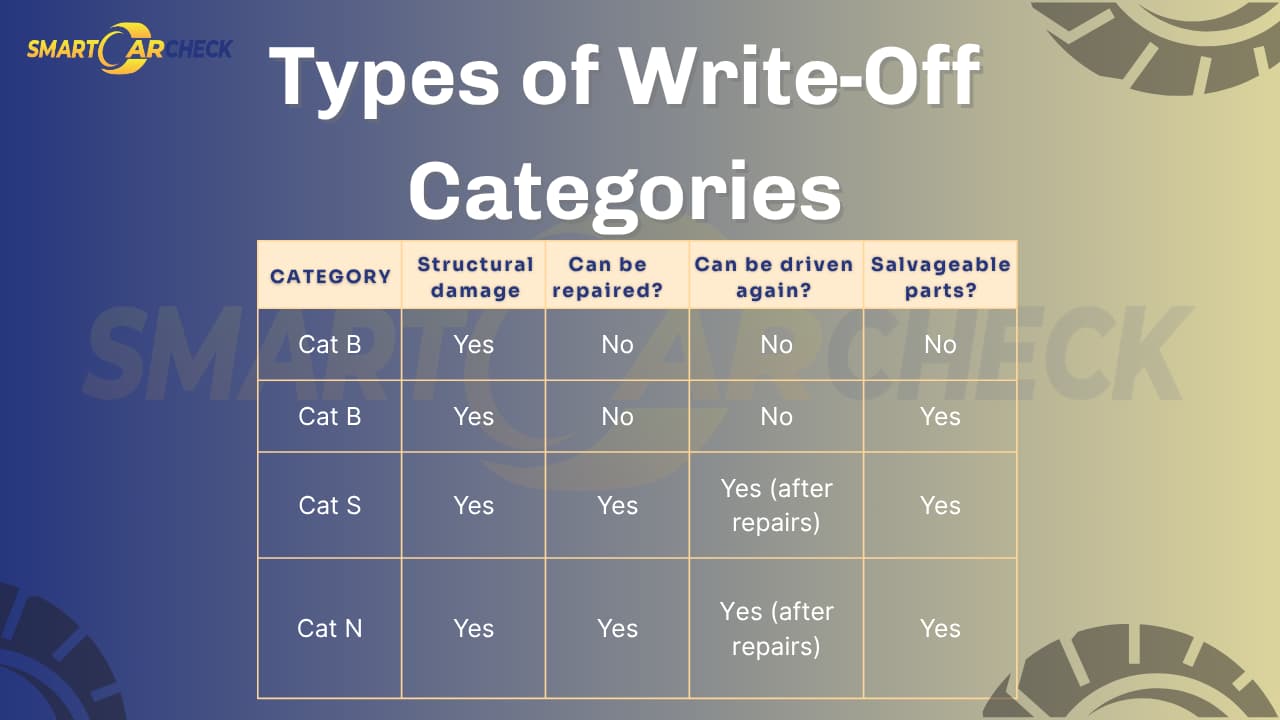When you look forward to buying a used car in the UK, you might stumble upon the term “Cat N” or “Category N” on the market or classified websites. It usually means that the car was in an accident, but not a bad one.
Many buyers ask this common question, “What is a category N?” Here, you will find a comprehensive explanation of what a Cat N is, whether you should buy it, and how to check if the car was marked as a Cat N.
What is Category N meaning on a car?
A car is placed in Category N (or Cat N) when it has been involved in an accident and written off by its insurer. It means that the vehicle was damaged, but not structurally, because the body or the chassis is still attached to the car. The “N” itself stands for “non-structural damage.”
The damage could be cosmetic, electrical, or mechanical, such as a broken bumper, faulty headlights, or engine problems. It used to be called Category D, but in 2017, the insurance industry updated the naming system. Cat D cars are now rare, but older vehicles written off before October 2017 may still carry the Cat D label.
Types of Write-Off Categories in the UK
Aside from category N, the UK mainly has four categories to mark the car or to write off the car, which are commonly used by insurance. Here are the write-off categories you need to know.

- Category A: The Car must be scrapped. Not even parts can be reused.
- Category B: The Car must be scrapped, but some parts may be salvaged.
- Category C: Serious structural damage, but they are still technically repairable. Read More about Category C
- Category D: Less serious damage, usually cosmetic or light mechanical issues. Read More about Category D
- Category S: Structural damage, repairable, but must be re-registered. Read More about Category S
- Category N: Non-structural damage, repairable, no re-registration needed.
Read Also: What are Insurance Write-Off Categories? A Detailed Guide
Simply put, a Category N car has not sustained structural damage, but it may still have issues with critical components such as the steering, brakes, or suspension, which can impact safety.
Common Types of Cat N Damage
Even though the damage isn’t structural, it doesn’t necessarily mean it’s minor. Category N can include issues such as:
- Cracked bumpers
- Smashed headlights
- Engine or gearbox issues
- Wiring or battery faults
- Cosmetic scrapes and dents
Some of these can be expensive to fix, which is why insurers decide it’s not economical to repair even if it’s technically possible.
Why do Insurers Declare a Car Cat N?
A car is typically given the Cat N category when the repair costs more than its market value. Since most insurance works on financial logic means that they calculate everything carefully, if a certain car’s repair cost is more expensive than the market price, then the car will be written off.
For instance, if a vehicle worth £1,500 needs £2,000 in repairs, the insurer will mark it as a total loss. However, it does not mean the car is scrapped, as some mechanics, dealerships, or individuals might purchase and repair the car for a cheaper price by using secondhand parts. Some Cat N vehicles may be surprisingly repairable and still have years of life left in them.
Can A Cat N Status Be Removed?
No, once the insurer has put the car in the Cat N category, it will stay there permanently, which means that you cannot remove or reclassify the category. This status is officially registered with the DVLA and will appear in any vehicle history report, making it known to prospective buyers, insurers, and dealers that the car was once written off.
Even if the vehicle is thoroughly repaired and consistently passes MOTs, the Cat N label remains part of its permanent record. It cannot be contested, removed, or altered.
Should You Buy a Cat N Car?
Yes, you can buy a cat N car if you do the check carefully. A cat N car can be safe to be driven once it’s properly repaired, since the damage wasn’t structural and the body is still intact on the car. It’s important to do your research before you decide to buy the Cat N car.
Inspect the Car Carefully
Don’t rely on a surface check done by yourself (if you are not a pro), it’s better to hire a mechanic to inspect the whole car, especially the electrical and safety systems if the car was flooded or has its airbag deployed.
Request the Car Repair History
Before you put any money into buying the car, it’s better to ask about the car’s repair history, or even the complete car history, to check if there are additional red flags to see.
Check If There Are Unfinished Repairs
Uneven body panels, illuminated warning lights on the dashboard, or malfunctioning electronics may point to poor quality or incomplete repair work.
Think About the Long-term Effects
It depends on the damage and repair quality. Stolen cars recovered in good shape are usually fine, but flood-damaged ones may suffer from rust or electrical issues later on, and you need to be aware of this because it would take a few repairs to be done to ensure everything is fine.
What’s the Worth of Cat N?
Typically, a Cat N vehicle is valued at 20% to 40% less than an identical model without any damage history. High-end and luxury cars may depreciate even more, not due to increased risk, but because their repairs are costlier and buyers tend to demand flawless condition.
The precise reduction in value depends on factors such as:
- The car’s age and mileage
- The severity of the initial damage
- The standard of the repair work
- The brand’s market reputation (as some brands maintain resale value better than others)
Is It Safe to Drive a Cat N Car?
Yes, Category N cars are road-legal once they’ve been properly repaired. They don’t need a special re-registration like Cat S cars, but it’s still wise to have an independent mechanic check the work before driving it.
Also, make sure to check the car’s MOT to see if it’s passed and insured.
Can Cat N Be Repaired?
Yes. Repairing a cat N is feasible since the car has sustained non-structural damage, while the chassis and frame remain intact on the car. Common damages include issues with brakes, suspension, steering, or cosmetic bodywork. However, you need to perform a detailed check before you decide to fix or repair the car.
However, repairs must be conducted properly, adhering to manufacturer guidelines and safety standards. While there’s no legal requirement for an independent inspection post-repair, obtaining one is advisable to ensure the vehicle’s safety
If you’re considering repairing or purchasing a Cat N vehicle:
- Conduct a Comprehensive Inspection: Have the vehicle inspected by a qualified mechanic or engineer to assess the quality of repairs and identify any underlying issues
- Review Vehicle History: Obtain a full service history and check for any outstanding recalls or issues with a car history report.
- Understand Insurance Implications: Consult with insurance providers to understand coverage options and premiums for Cat N vehicles
- Be Transparent When Selling: Always disclose the Cat N status to potential buyers and provide documentation of repairs and inspections.
Should You Buy a Car With Cat N?
You should carefully consider the pros and cons of buying a Cat N car to know what you are about to get. Here are the pros and cons you need to consider.
Pros:
- Often cheaper than non-damaged cars
- May only have minor cosmetic issues
Cons:
- It can be harder to sell later
- Insurance may cost more
- May have underlying issues that aren’t visible
If you’re buying, ask for before-and-after photos, repair invoices, and get a car history check. Before purchasing, always check the UK auction history before buying a Cat N car to see past damage and check if the vehicle has ever been sold at an auction.
How To Check If The Car Is Cat N?
Don’t take the seller’s word lightly; you need to check the car in order to know if it’s marked as a cat N. Without checking the car’s history, you will end up with a car that probably has more issues to be taken care of, instead of “just” a Cat N. If a Cat N car hasn’t been properly repaired, you might end up spending more on the other issues.
Conclusion
If you ever plan to buy a used vehicle, be sure to check the car’s history. Use our car check tool, or you can use tool VIN check tool, to see the history of your vehicle using VIN number. With this tool, you do not end up buying a car with an N category. The car might be cheaper than any used car, but are you ready to fix and maintain all of the issues? Think again!
Frequently Asked Questions on Cat N Meaning
Which category is bad, S or N?
Category S is worse because it means the car has damage to its main structure. Category N cars have no frame damage, only things like lights, wires, or small parts are affected.
Is it hard to sell a category N car?
Yes, it can be harder. Some buyers may avoid it because of its past damage. You might need to show repair records and lower the price to make the sale easier.
Does a category N need a new MOT?
Not always. If the car already has a valid MOT, you can still use it. But after any repairs, it’s a good idea to get a fresh MOT for peace of mind.
Can a Category N car pass an MOT?
A Category N car can pass an MOT if it has been correctly repaired and meets all safety and emissions standards. Since the damage is non-structural, passing the MOT depends on roadworthiness, not on the car’s write-off history or insurance category.
Are Cat N cars road legal?
Category N cars are road legal once repaired. They can be driven normally after passing an MOT test. The classification means the vehicle had non-structural damage. Once fixed properly, it is legal to drive, although the Cat N status remains on record.
Will Cat N affect my insurance premium?
Owning a Cat N vehicle often results in higher insurance premiums. Some insurers may charge more due to perceived risk or reduced resale value. Others might decline coverage. It is essential to disclose the status when applying to avoid invalidating the policy.
How do I know a Cat N car was repaired properly?
Check for repair invoices, service records, and ask for an independent inspection by a qualified mechanic. Look beyond cosmetics and confirm safety systems like steering, brakes, and suspension work correctly.


